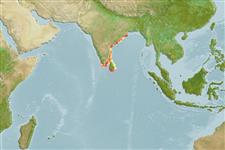>
Scombriformes (Mackerels) >
Trichiuridae (Cutlassfishes) > Trichiurinae
Etymology: Lepturacanthus: Greek, leptos = thin + Greek, oura = tail + Greek, akantha = thorn (Ref. 45335).
Environment: milieu / climate zone / depth range / distribution range
Ecología
marino; salobre bentopelágico; rango de profundidad 0 - 80 m (Ref. 6181). Tropical; 21°N - 5°N, 76°E - 87°E (Ref. 6181)
Distribución
Países | Áreas FAO | Ecosistemas | Ocurrencias, apariciones | Point map | Introducciones | Faunafri
Indian Ocean: Hooghly estuaries to Gulf of Mannar in the east coast of India.
Tamaño / Peso / Age
Maturity: Lm ? range ? - ? cm
Max length : 92.0 cm TL macho / no sexado; (Ref. 6181); common length : 40.0 cm TL macho / no sexado; (Ref. 6181)
Short description
Morfología | Morfometría
Espinas dorsales (total): 3; Radios blandos dorsales (total): 121-131; Espinas anales 2; Radios blandos anales: 74 - 84. Body extremely elongate, compressed and tapering to a point. Anal fin reduced to a long spine and 74 - 84 smaller spinules; pelvic and caudal fins absent. Lateral line running nearer the ventral contour than the dorsal contour of the body. Body color steely blue with metallic reflections in fresh specimens, becoming silvery gray after death.
Benthopelagic or pelagic in estuaries and coastal waters. Feeds on a wide variety of small fishes and crustaceans chiefly on prawns, young clupeoids, Harpodon nehereus and Trichiurus spp. in Hooghly estuaries, India. Caught mainly with bag nets in estuaries, with shore seines and boat seines in inshore waters, and with trawls in off-shore waters. Marketed fresh as well as dried salted.
Life cycle and mating behavior
Madurez | Reproducción | Puesta | Huevos | Fecundidad | Larva
Nakamura, I. and N.V. Parin, 1993. FAO Species Catalogue. Vol. 15. Snake mackerels and cutlassfishes of the world (families Gempylidae and Trichiuridae). An annotated and illustrated catalogue of the snake mackerels, snoeks, escolars, gemfishes, sackfishes, domine, oilfish, cutlassfishes,. scabbardfishes, hairtails, and frostfishes known to date. FAO Fish. Synop. 125(15):136 p. (Ref. 6181)
IUCN Red List Status (Ref. 130435)
Threat to humans
Harmless
Human uses
Pesquerías: escaso valor comercial
Más información
Nombres comunesSinónimosMetabolismoDespredadoresEcotoxicologíaReproducciónMadurezPuestaAgregación para la puestaFecundidadHuevosEgg development
Age/SizeCrecimientoLength-weightLength-lengthLength-frequenciesMorfometríaMorfologíaLarvaDinámica larvariaReclutamientoAbundanciaBRUVS
ReferenciasAcuiculturaPerfil de acuiculturaRazasGenéticaElectrophoresesheritabilidadEnfermedadesProcesamientoNutrientsMass conversion
Herramientas
Special reports
Download XML
Fuentes de Internet
Estimates based on models
Phylogenetic diversity index (Ref.
82804): PD
50 = 0.6250 [Uniqueness, from 0.5 = low to 2.0 = high].
Bayesian length-weight: a=0.00191 (0.00078 - 0.00466), b=3.11 (2.90 - 3.32), in cm total length, based on LWR estimates for this (Sub)family-body shape (Ref.
93245).
Nivel trófico (Ref.
69278): 4.1 ±0.71 se; based on food items.
Resiliencia (Ref.
120179): Medio, población duplicada en un tiempo mínimo de 1.4-4.4 años (Preliminary K or Fecundity.).
Fishing Vulnerability (Ref.
59153): High vulnerability (57 of 100).
